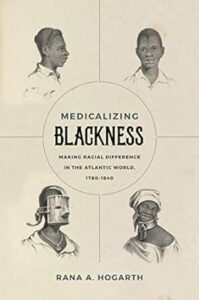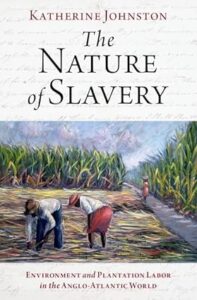Medicalizing Blackness: Making Racial Difference in the Atlantic World, 1780-1840 – Rana A. Hogarth.
 Medicalizing Blackness: Making Racial Difference in the Atlantic World, 1780-1840. By Rana A. Hogarth. (Chapel Hill: The University of North Carolina Press, 2017. 193 pp. Paper, $27.95.)
Medicalizing Blackness: Making Racial Difference in the Atlantic World, 1780-1840. By Rana A. Hogarth. (Chapel Hill: The University of North Carolina Press, 2017. 193 pp. Paper, $27.95.)
At the end of Rana Hogarth’s treatise on the intersection between black bodies and the origins of scientific racism as seen through the lens of the medical profession in Early Republic and antebellum America, Hogarth states, “Throughout this book, I have refrained from offering judgment on the efficacy of physicians’ treatments or the correctness of their theories in the past. In doing so, I have tried to draw attention to the process through which physicians produced medical knowledge about blackness” (193).
Though I understand the historian’s inclination to probe the meaning of historical phenomena over the search to discover correctness of the subjects we study, I believe in this case the omission of factual truths about how diseases affected blacks and whites to be the greatest weakness of this book. Omitting facts about how yellow fever, for example, affected blacks and whites as opposed to just examining how different thinkers conceptualized the root of black pathology weakens Hogarth’s narrative, as, in their absence, it is entirely impossible for the reader to truly understand the baselessness of white medical partitioners’ claims. The truth here is just as important in breaking down the constructedness of white perceptions of supposedly different responses to illness between blacks and whites.
Hogarth’s work is only half done in this book. It is possible to investigate the history and meaning a social construct without sacrificing an examination of what the historical record actually says about facts. If we don’t know or cannot ascertain reliable facts that is one thing, and should be highlighted as such. But if we do have reliable facts about the subject of our work, as in the case of Medicalizing Blackness, it makes our work all the stronger because we can contrast the meanings and outcomes of misconceptions with the truth those forces tried to hide.
 All history, at the very end of the day, is guesswork. One thing Hogarth emphasizes over and over is how scarce sources were able for her study, making most of what she reads from the few existent sources read like guesswork. I also find it hard to believe. As Katherine Johnston’s The Nature of Slavery: Environment and Plantation Labor in the Anglo-Atlantic World demonstrates, there are ample sources available to construct a compelling narrative about the medical construction of race while investigating instead obfuscating historical facts. Johnston pairs an investigation of a social construct by not only laying bare ideas about race, but also by comparing these ideas with the realities on the ground that refute or support them.
All history, at the very end of the day, is guesswork. One thing Hogarth emphasizes over and over is how scarce sources were able for her study, making most of what she reads from the few existent sources read like guesswork. I also find it hard to believe. As Katherine Johnston’s The Nature of Slavery: Environment and Plantation Labor in the Anglo-Atlantic World demonstrates, there are ample sources available to construct a compelling narrative about the medical construction of race while investigating instead obfuscating historical facts. Johnston pairs an investigation of a social construct by not only laying bare ideas about race, but also by comparing these ideas with the realities on the ground that refute or support them.
Medicalizing Blackness explores important historical actors in the supposedly scant sources Hogarth employees, but this book begs further exploration. If the source base is not there, it might be impossible to corroborate the claims Hogarth makes in the historical narrative. I applaud Hogarth for taking this subject on, but I am also glad that we have Johnston’s work to give us a better picture of what it meant to be black and enslaved and encounter disease in antebellum America.
